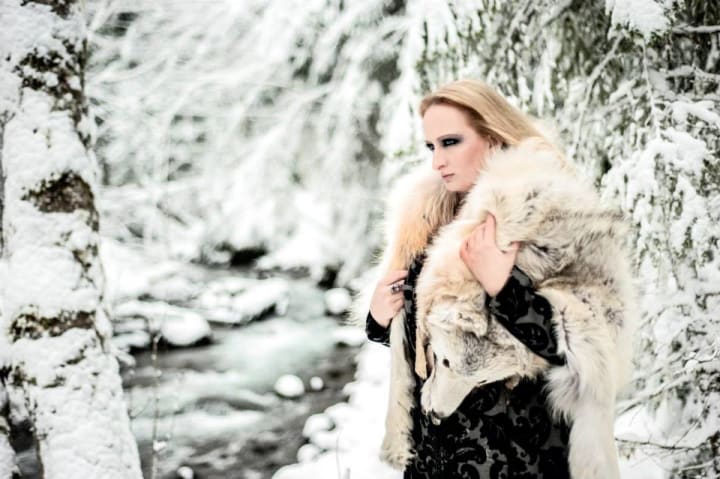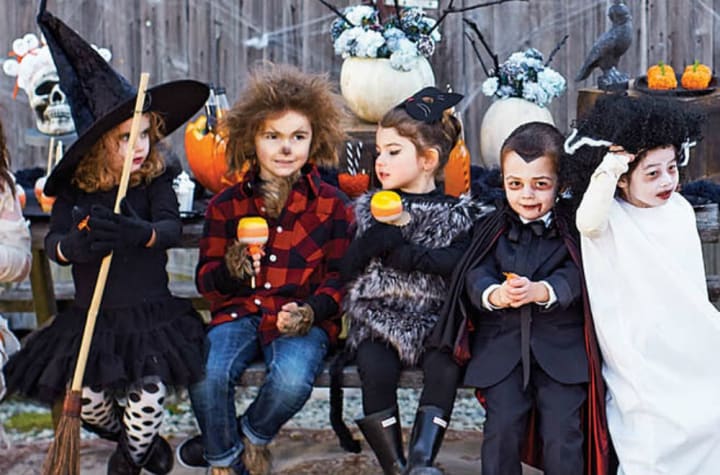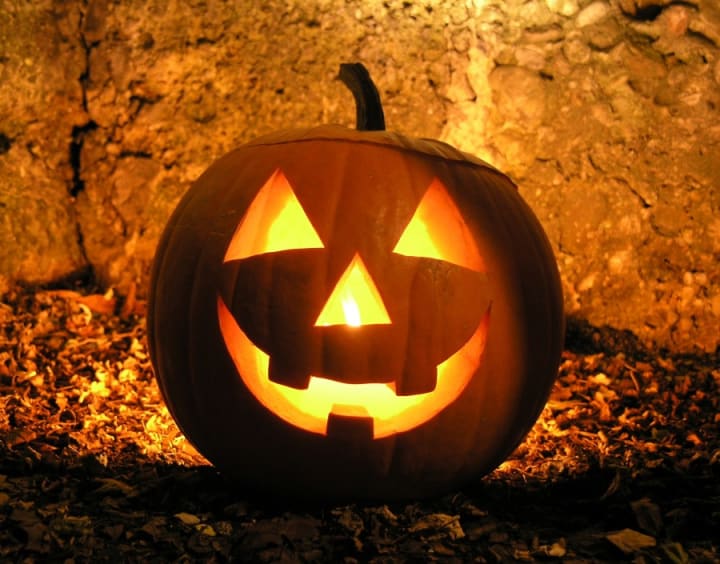The Curious Origins of Your Favorite Halloween Traditions
Pumpkins, Candy, and Costumes, Oh My!

Whether you're an avid fan of the confection fueled holiday, or the neighbor everyone secretly resents for turning off all your lights and hiding behind the sofa, Halloween is fairly inescapable. With the day in question fast approaching in all its plastic-masked, sugar-drenched glory, now is the perfect time to take a closer look at the many strange and spooky traditions we practice each year. For example:
Where did Halloween come from anyway?
Most sources trace the origins of what we now call Halloween back to the Celtic festival of Samhain (pronounced sow-in). The Celts roots stretch back around 2000 years to the rolling hills of what is now Ireland, the United Kingdom, and northern France, and the threads of their beliefs are woven haphazardly throughout countless traditions and superstitions we celebrate in modern times.
The Celts celebrated their new year on November 1st, a day they believed represented the end of summer and the harvest, and the beginning of the harsh winter. Because of the threatening nature of the impending cold season, and its association with death and darkness, on the eve of the New Year, Celtic lore dictated that the lines between the living and the dead blurred. Ghosts crossed into the waking world to run wild for a single night, damaging crops and causing a variety of small ills before the veil once again solidified and separated the two realms.
It wasn't all mischief or veggie vandalism, though.
The Druids (Celtic priests) believed that the spirits' presence on earth made it easier to divine future events and form prophecies, something that historians now believe was crucial in maintaining the morale of the people through the unforgiving winter. Priests and villagers alike attempted to draw their own bits of whimsical magic from the night, attempting to predict future marriages and the upcoming deaths.
The celebration of Samhain itself was an elaborate affair. People clothed themselves in costumes made of animal skins, and gathered around sacred bonfires built by Druids, offering crops and animals to the fire in sacrifice to their deities and taking shots at telling each other's fortunes. When the night drew to a close, torches would be dipped into the bonfires, slivers of their flames stolen to light the hearths of the celebrants and usher in the New Year.
Obviously, the way we celebrate the holiday has undergone some significant changes since then. If you lit a massive fire in your town square and started tossing sheep and baskets of potatoes into the flames, you'd probably spend Halloween in a jail cell avoiding Jimmy "trick-or-treat" Jones. (No, you don't want to know where he got the nickname or what happened to his front teeth.)
The framework of the modern holiday can be largely credited to the Romans, who by 43 AD had conquered most of the Celts' lands, and moved themselves and their traditions in. They ruled the area for around 400 years, during which time the festival of Samhain was squished together with two traditionally Roman celebrations, Feralia and the festival of Pomona.
Feralia occurred in late October, and was set aside by the Romans as a day of observance for the passing of the dead, something that has fairly obvious similarities to the original purpose of Samhain. The second holiday, however, was in honor of Pomona, the Roman goddess of fruit and trees. Pomona's symbol, the apple, and its integration into the Celtic holiday is theorized to be the reason many modern Halloween parties practice "apple bobbing."
No one slapped the name "Halloween" on the Holiday until around the 1000 AD. Christianity had stamped out most of the Celtic rites and ancient traditions previously celebrated, tweaking them here and there and rebranding them as church holidays. They would eventually name November 2nd "All Souls Day," making it a day to honor the dead. The new festival was celebrated much the same as Samhain had been, with huge bonfires and costumes, and parades. The name "All Souls Day," would be passed around, mangled and shortened time and time again, going from "All Hallows" to "All-Hallomas" to "All Hallows Eve" and eventually settling as simply, "Halloween."
Why do we dress up?

"Susan? Is that you? Oh, no, wait, my bad that's just a bi-pedal wolf man. Carry on."
The tradition of dressing up for Halloween originates with the Celts as well, although it wasn't always sexy kitty cats and poorly constructed visual puns. The first Halloween costumes were those animal skins we talked about earlier, and they weren't patched together to collect candy compensation.
The Celts believed that going out into the ghost packed darkness of Samhain was a risky venture, and to keep their dead acquaintances from recognizing them and causing them harm, they used animal skins and masks to disguise themselves for the night's celebration.
This tradition was carried over into the church-edited Roman version of the holiday, All Souls Day, in which citizens would gather for parades dressed as saints, angels, and devils.
Eventually, around the 16th century, people began taking their costumes door to door, "mumming" or singing songs in exchange for food, and using the masks both to hide their identity from the those they were begging from, and to represent the spirits of Winter.
Today's Halloween costumes are a far stretch from saints, and chances are the sexy kitties of the world aren't donning their whiskers to escape dead Aunt Judith's wrath, but they do owe their creation to those older traditions.
Popularization of costumes and mass production of Halloween attire in the United States can be traced back to the 19th century and the birth of the Halloween party. For a time, it become an almost entirely childish holiday, with only the youth participating in costumed revelry. But, thankfully, someone, somewhere, remembered that Halloween was perhaps their only chance to dress up as a giant bumble bee and get absolutely hammered on candy flavored vodka, and thus the holiday shifted back into an all ages event.
Why do we allow our children to go to strangers' houses and demand candy?

"Listen, Jimmy, forget everything I ever taught you about strangers and candy. Put on this Power Rangers suit and get the hell out."
Every year, thousands of children are stuffed into the cheap polyester skins of their favorite cartoon characters and set loose on the frightened, candy bearing denizens of their neighborhoods. Armed with grinning pumpkin buckets and an insatiable desire for mini chocolate bars, they pour into the streets, trampling gardens and abusing doorbells everywhere. But, why?
Why do we let our otherwise well-guarded offspring flood the city and pound on total strangers' doors to demand edible compensation for their efforts?
Trick-or-treating, like most Halloween traditions, goes all the way back to the Celts and the Romans.
Originally, however, it wasn't candy that door-to-door Halloween harassers were after. Historians best guess is that the practice was born from "going a-souling." Souling was a Christian tradition, in which the poor of the city would travel from home to home begging for food. The families within would give them "soul cakes," pastries baked specially for the holiday, in exchange for promises that the soulers would pray for the family's dead relatives. This was an activity encouraged by the church in an attempt to replace the old tradition of leaving offerings of food and wine for roaming spirits, and eventually it evolved into something closer to today's trick-or-treat frenzy, with children visiting neighborhood homes and collecting ale, food, and money.
Now, obviously we no longer shower costumed children with free booze and cash, so clearly there were a few edits made along the way.
Candy became the primary trick-deterrent in the early nineteen hundreds, following the candy industry's invention of "Candy Day." "Candy Day," was set on the 2nd of October, and promoted as a "friendship holiday." While the entire thing was invented to boost fall candy sales, it still found success, because, well, everybody loves candy. It would later be renamed "Sweetest Day," and continued into the 1950s.
Thanks to some brilliant marketing campaigns, the holiday was eventually shifted into a Halloween add-on. Through the fifties and sixties, children were still receiving coins, nuts, and the occasional baked good from neighborhood homes, but as trick-or-treating became more and more popular across the country, parents realized it was much easier and cheaper to simply buy bulk candy to pass out to the kiddies.
By the seventies, candy was the predominant currency of Halloween exchanges, and modern Americans now spend a whopping 6 billion annually on stuffing local children with processed sugar.
Why do we carve pumpkins?

Every November, hundreds of pumpkins slowly rot on porches across the country, their crooked faces wilting into wrinkled masks of dead-gourd horror until the homeowner finally admits to themselves that their orange friend's time has passed. But why do we carve jack-o-lanterns in the first place?
The tradition evolved from an Irish folk tale about an unfortunate individual by the name of "Stingy Jack."
Jack, an aptly named and miserly man, invited the Devil out for a drink. When the bill arrived however, Jack couldn't bring himself to cough up the cash, and instead convinced the Devil to transform into a coin to cover the debt. Once Jack saw the former prince of darkness' shiny new form, he couldn't bear to part with it, instead choosing to keep it in his pocket alongside a silver cross that trapped the Devil in his coin-state.
Eventually, Jack freed the Devil from his pocket prison, but not before extracting a promise from from him to leave Jack alone for a year, and should he die, not to claim his soul.
A year later, when the Devil returned to settle his debts, he was again made the fool. Jack tricked the Devil into climbing into a tree to pluck a particularly appealing piece of fruit, and while he was struggling through the branches, quickly carved the sign of the cross into the bark of the tree, trapping the Devil yet again. This time, he made the Devil promise to stay away for ten years.
Unfortunately for Jack, he didn't live to see the end of his ten years, instead dying shortly after the fruit tree fiasco. God, having witnessed Jack's questionable behavior over the years, refused him entry into Heaven and since the Devil had promised not to claim his soul, he found no place in Hell, either. Instead, the Devil sent him away armed with a burning coal to light his way in the waiting night. Jack, in a predicament of his own making, placed the coal into a carved out turnip and set to roaming the Earth for all eternity.
The Irish began to refer to him as "Jack of the Lantern," and eventually "Jack O'Lantern" and people in Ireland ad Scotland took to making their own lanterns from turnips and potatoes, placing them in windows to ward off Stingy Jack and any other ill-meaning spirits. When their descendants migrated to the United States, the tradition was carried on with the use of pumpkins and the modern jack-o'-lantern was born.
Millions of Americans will be celebrating Halloween this year, donning cheap Zorro masks and dollar store bunny tails to collect candy and the drunken admiration of frat boys nationwide, and love or hate the holiday, chances are you'll be partaking somehow. So, while you'll probably never need any of the information you now know, and that girl you've been trying to explain jack-o-lanterns to over the deafening roar of Monster Mash for the last ten minutes probably won't remember it in the morning, at least now you've got a recitable list of Halloween facts to distract people from the fact that your costume is literally just a t-shirt with paper taped to it. You're welcome.
About the Creator
Teyana Jackson
An aspiring writer and poet currently living on the East Coast. More work can be found on allpoetry.com, thebluenib.com, and in the poetry anthologies "Circular Whispers" and "Seasonal Perspective"







Comments
There are no comments for this story
Be the first to respond and start the conversation.